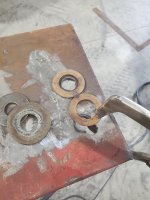I just discovered safety wire.
Finally got one of those dohickys for clamping using stainless safety wire. Bought mine from Aircraft Spruce up here in Canada, along with 4 lbs of stainless safety wire.
100% would recommend. Also nice that you can goober one together yourself out of little bits of scrap metal (see video below).
I definitely need practice making them look nice, as it's a pain to keep all the wires from crossing each other, especially when working in a shit spot.
Also of note is the fact that you don't need to rotate the tool to bend the wire (which is not possible in tight quarters). You can simply rotate the tool a little bit then keep bending tension as you loosen the tool (hard to explain, but happens naturally when it's in your hands).
This one is the clamptite.
You can also easily make your own version out of scrap steel (skip to 5:14 in video to see one make from a flat bar and a piece of roundbar. (The rest of the video is also worth watching!)








